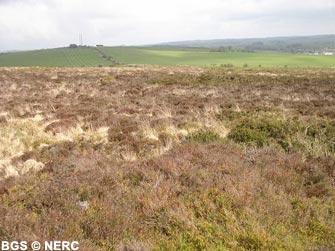
Typical Mendip habitats
Introduction | Unimproved limestone grassland | Acid dwarf-shrub heath | Ash woodland
Acid dwarf-shrub heath

On the summit of Blackdown Hill, at Priddy Mineries, and in small fragments elsewhere, a distinctive heathland vegetation of dwarf ericaceous (acid-loving) shrubs has developed. This is usually dominated by ling, with western gorse and varying amounts of bell heather and, where locally impeded drainage or flushes occur, cross-leaved heath.
Heathland invariably indicates poor conditions within the upper level of the soil, and its plants are types well adapted to coping with very dry soils, wind exposure, low nutrients, and acidic soils. Although heathland tends to be quite species poor, it supports plants and animals that have a very restricted ecological niche, and is therefore very important in biodiversity terms. Once extensive throughout Britain, significant tracts of lowland heath are now quite rare, and confined to parts of Dorset, Hampshire, Cornwall and a few other specific areas.
- Home
- Overview maps
- Locality
areas
- Cheddar Gorge
- Charterhouse
- Blackdown
- Burrington Combe
- Shipham & Rowberrow
- Crook Peak & Axbridge
- Banwell to Churchill
- Priddy
- Harptree & Smitham Hill
- Draycott & Westbury-sub-Mendip
- Wookey Hole & Ebbor Gorge
- Wells
- Great Elm & Vallis Vale
- Mells & the Wadbury Valley
- The Vobster area
- The Whatley area
- Torr Works & Asham Wood
- Beacon Hill
- Stoke St Michael & Oakhill
- Holwell & Nunney
- Shepton Mallet & Maesbury
- Gurney Slade & Emborough
- The Nettlebridge valley
- Geology
- Minerals and mines
- Quarrying
- Caves and karst
- Biodiversity
- Detailed site information
- Acknowledgements
- External links
- Search
- Site map